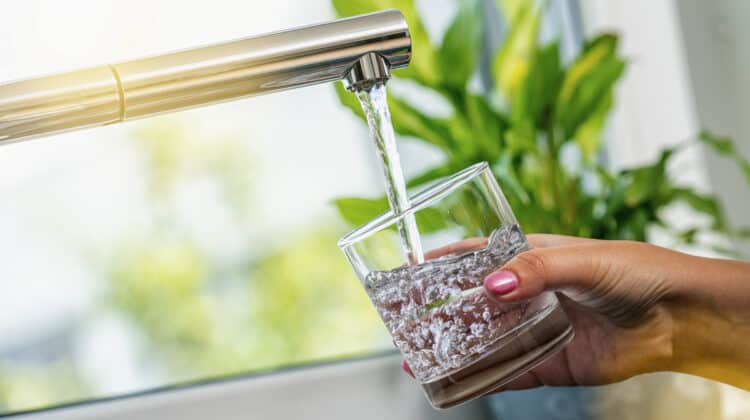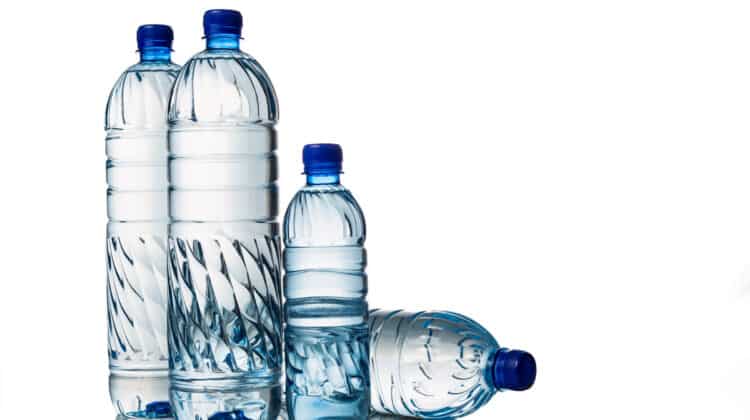
Water is essential for life. It gives nourishment, rehydrates, and cools down your body. Experts recommend drinking up to eight glasses of water every day. But which type should you drink: bottled water vs tap water?
The debate on bottled water vs. tap water has been going on for the past few years. The scales have favored one, only to get outweighed by the other side a few years after. Recent research data and government regulations can also affect the outcome of discussions.
For example, water safety has been a big concern for tap water with the decline in clean water sources. So, district water suppliers use sewage water and recycled water from farms. This argument favors bottled water.
But, with safety guidelines from the EPA, tap water is now much safer and cleaner. At the same time, toxic substances were in the plastic packaging of bottled water. It now favors tap water.
Bottled water vs. tap water is not a simple issue. Both have advantages and disadvantages. You will have to decide which one is best for your needs, situation, and financial capacity. We will dissect bottled water vs. tap water to help you make the best decision.
Table of Contents
What are the advantages of tap water?
Tap water is also known as municipal water or faucet water. It gets water from lakes and rivers, underground wells, or dams. Afterward, it distributes water to homes and offices by using a network of pipes. Tap water has a variety of uses. You can drink, cook, wash, and clean with it.
The government manages the water supply of a city or municipality. Sometimes, it can commission a private company through a long-term franchise agreement. But only one entity can manage it at any given time. You cannot choose your tap water provider.
It is understandable since there is only one pipeline system for the whole city. Imagine if you have three water providers who have their pipe systems. The city will then be on top of a network of pipes that can collapse anytime. With one leak, everything will get washed away!
Also, having only one water supplier will keep the water standards uniform. It uses the same water source, filtration systems, and water pressure. Additionally, monitoring and inspection will be easier.
Tap water is the responsibility of the EPA or the Environmental Protection Agency. It identifies the standards to keep drinking water safe. It also sets the limits and treatment methods for the more than 90 contaminants in the US water supply.
But the EPA only regulates public water supply. If you use private well water as the source for your tap water, it is your responsibility to keep your water clear. Arrange to have your water sample tested by a local laboratory at least once a year. It will help to identify if bacteria and other contaminants are present in your deep well water.
Now let us look at four areas where tap water has the advantage in the bottled water vs. tap water debate.
- Safety.
- Taste.
- Cost and convenience.
- Impact on the environment.
What is the safety rating of tap water?
You may wonder if tap water is safe for drinking. You know that you can use it to clean the house, wash your clothes, and water the plants. The truth is, with the EPA standards in place, tap water is one of the safest drinking waters today.
Tap water is undergoing tests and analysis. And every time, more treatment and control make the water as healthy as possible. Also, the water supplier publishes an annual report on contamination levels. Aside from updating you, it can also help you decide if you need water filters as extra protection.
There are many stages involved in the treatment of tap water. Coagulation removes dirt and other solid particles. Next, water passes through layers of sand, gravel, and charcoal. Then chlorination kills bacteria and other organisms. The filtered water then gets inside storage tanks ready for distribution to the public.
But tap water is not always kept to the highest standards. Natural disasters can contaminate the public water supply. Floods and hurricanes are examples of such emergencies. In these cases, tap water may fall above the limits of contamination set by the EPA.
Sometimes, extraordinary situations also happen because of human error or negligence. Take the Flint water crisis in 2015 as an example. In this case, there was too much lead and bacteria in tap water distributed to the residents of Flint, Michigan. Lead contamination is poisonous and may result in mental and physical defects in children.
What is the taste of tap water?
The next stage in the bottled water vs. tap water battle is comparing taste. People believe that tap water is bland. And that bottled water tastes much better. But recent experiments prove the opposite.
In blind taste tests, participants drank water samples from both the tap and bottled waters. Then they were asked to tell which one is tap water and which one is bottled water. The result is that about 65% were not able to tell the difference between the two. Tap water tastes the same as bottled water.
Some types of bottled water will have a different and distinct taste. It includes flavored water and sparkling water. Also, some bottled mineral or spring water will have a metallic aftertaste depending on the concentration of minerals. These are exemptions. In general, tap water will have the same taste like bottled water.
How much is tap water, and is it convenient?
The next round in the bottled water vs. tap water battle is cost and convenience. Tap water is cheaper compared to bottled water. Estimates show that bottled water is 1,000 to 2,000 times more expensive than tap water. A gallon of tap water only costs 1 cent, while bottled water averages $1 to $2 per 300 milliliters.
There are also areas where you can get tap water for free. Find drinking fountains near stadiums and parks. Most restaurants and bars also serve tap water for guests. You only need to ask for it from the waiter or food server.
Tap water is also convenient to get. You only need your glass or mug and the water faucet. Turn on the faucet, catch the water, and sip the water. These are three easy steps to enjoy tap water at home.
What is the impact on the environment of tap water?
As discussed earlier, tap water goes through many stages of filtration and treatment. It uses energy to regulate the flow of water from the source to the treatment facility. Once inside, the filtration processes need electric power, and then it produces heat. Chemicals such as chlorine disinfect the water and kill bacteria.
Once it reaches your home, you need to exert energy to open the faucet and drink from the glass. Afterward, you wash the glass manually or through a dishwasher. All these steps will leave a carbon footprint and will affect the environment.
But these are only minimal impacts to the earth. And since there is no plastic or packaging involved in drinking tap water, there is no harmful waste thrown. If not disposed of properly, plastic can pollute our water and increase trash on the streets.
What are the advantages of bottled water?
Bottled water is water stored in non-toxic and food-grade plastics. It comes from well water, underground springs, or the public water supply. It is for personal consumption and almost exclusively used for drinking. Some people use it for cooking and washing food, but it is rare since bottled water is expensive.
Bottled water is under the supervision of the FDA or Food and Drug Administration. It monitors and ensures that bottled waters sold to the public are safe. It conducts factory inspections to determine if the water source is acceptable. The FDA also inspects the production line to ensure that sanitation, bottling, and storage are of the highest standards.
There are five areas where bottled water has the advantage in the bottled water vs. tap water discussion.
- Multiple sources and variety.
- Safety.
- Convenience.
- R&D or Research and development.
What is the water source for bottled waters?
Bottled water comes from a variety of sources. It can come from a spring, underground well, or tap water. It is the reason why bottled water has different tastes and textures. For example, spring water will have a distinct metallic taste and smell from the natural minerals.
This characteristic of bottled water explains why the FDA also has several approved labels for bottled drinking water. Some of them are artesian water, mineral water, and spring water. Under purified water, we have deionized water, distilled water, and reverse osmosis water.
The variety of bottled water is empowering for consumers. It gives them the power to choose what they want for that moment. And more choices like sparkling water, tonic water, and flavored water make it to the list. Now there is more than enough option for your every mood and want.
Are bottled waters safe to drink?
A vital aspect in the bottled water vs. tap water battle is safety. All bottled water manufacturers follow the strict standards set by the FDA. The agency set up the Current Good Manufacturing Practices or CGMPs that requires manufacturers to:
- Process and deliver bottled water under sanitary conditions
- Ensure that water sources are free from bacteria and other pollutants
- Utilize QC and QA processes for water safety
- Test and sample two times for contaminants. First is at the water source, then after bottling procedures.
The FDA monitors compliance and inspects the whole production line of bottled waters to ensure that the finished product is safe. By adhering to strict standards, consumers can be confident that the bottled water they have is non-toxic and free from harmful substances.
Also, some types of bottled water help people with medical conditions or special needs. For example, patients with cancer or low immunity should drink reverse osmosis water or deionized water. It helps to keep impurities and chemicals from tap water away from them since they are vulnerable to infection and adverse reactions. Pregnant women and small children should also avoid tap water and drink filtered water instead.
Recent studies show a risk for microplastic contamination from drinking bottled water. Research conducted in 2018 analyzed eleven bottled water brands from nine countries. Results indicate that 93% of bottles have microplastic contamination. But this substance is also present in tap water. The levels are just lower in tap water by one-half.
More studies are on the way for microplastics and their impact on the health of people. These substances seem to affect reproduction rate, oxidation, and metabolism. But there is no proof to support this conclusion yet.
How are bottled waters convenient?
There are situations when access to running water is impossible. During a marathon, it is convenient to grab a bottled water and throw it out after.
Also, bottled water is available almost everywhere. Your 24-hour convenience store, grocery, and gasoline station shop all sell it. You can also get it iced cold that is perfect for the hot summer months.
Have you gone to a fast-food restaurant recently? Notice that they now offer meals that come with bottled water. It is perfect for people who want to cut down on sugar and calories from soda and other carbonated drinks. And the best thing is you do not have to pay extra since meals come with bottled water.
What is R&D in the bottled water industry?
Plastic waste is the biggest issue against bottled water in the bottled water vs. tap water debate. While plastic bottles do pose environmental hazards, it is the attitude of people that makes it worse. You will see them throwing plastic bottles everywhere. And these wastes reach our sources of drinking water.
As a start, the industry has made improvements in the plastic bottles used. Previously, these bottles used BPA. It has effects on reproductive and heart health. The industry responded by introducing BPA-free packaging.
Today, manufacturers are looking for alternatives to plastic bottles. Some research and development efforts have led to the development of paper water bottles that are 100% biodegradable. There are also plant-based plastics or bioplastics currently under testing.





